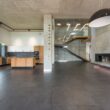A
Accent Lighting: Lighting used to highlight a specific area or object in a room, like artwork.
Acrylic: A durable, synthetic material often used in furniture or decor for its clarity and lightweight qualities.
Ambient Lighting: General, soft lighting that illuminates a room without focusing on specific areas.
Analogous Colors: Colors adjacent to each other on the color wheel, often used to create harmonious designs.
Antique: A piece of furniture or decor that is at least 100 years old, prized for its history and craftsmanship.
B
Balance: The equal distribution of visual weight in a room, either symmetrically or asymmetrically.
Bay Window: A large window that projects outward from the wall, often creating extra seating or space.
Beadboard: Vertical wooden panels, commonly used in cottage-style or traditional designs, for walls or ceilings.
Biophilic Design: A design approach that incorporates natural elements like plants and water to promote well-being.
Bohemian: An eclectic style characterized by vibrant colors, global patterns, and an informal, collected feel.
C
Cohesion: The sense that all elements in a room work together harmoniously.
Color Temperature: The warmth or coolness of light, measured in Kelvins, affecting the mood of a space.
Console Table: A narrow table placed against a wall or behind a sofa, often used for decorative display.
Crown Molding: Decorative trim installed where walls meet the ceiling, often used in traditional and formal spaces.
Curated: The careful selection and arrangement of objects or furniture to create a thoughtful design.
D
Daylighting: The practice of using natural light to illuminate interior spaces, often through large windows or skylights.
Direct Lighting: Lighting that shines directly onto an object or area, often used for task lighting.
Distressed: A furniture or decor finish that is purposely aged or weathered to create a worn, vintage appearance.
Drapery: Fabric window treatments that hang in soft folds, often used for light control and decoration.
Dual Functionality: Furniture or decor designed to serve more than one purpose, such as a sofa bed.
E
Eclectic: A design style that mixes elements from various periods, styles, and influences.
Ergonomics: The study of designing spaces and furniture for comfort, functionality, and ease of use.
Etagere: An open-shelving unit used to display decorative objects, often made of wood or metal.
Exposed Beam: Ceiling beams left visible for decorative purposes, often seen in rustic or industrial designs.
Elevation: A vertical design drawing that shows the side of a building or room, including walls and structural details.
F
Faux Finish: A decorative painting technique used to mimic the look of materials like marble, wood, or stone.
Feng Shui: The ancient Chinese practice of arranging spaces to balance energies and promote harmony.
Flat Weave: A rug or carpet made without a pile, known for its durability and clean lines.
Fluting: Decorative vertical grooves often used in columns, furniture, or moldings.
Footprint: The total area that a piece of furniture occupies on the floor.
G
Gallery Wall: A curated arrangement of photos, artwork, or other wall decor, often hung in a grid or asymmetrical layout.
Glam: A luxurious design style characterized by metallic accents, rich fabrics, and bold patterns.
Grommet: A circular metal or plastic ring in fabric (such as curtains) that allows it to be hung easily.
Grid Layout: A structured, linear arrangement of design elements, often used in room planning.
Green Design: A sustainable approach to design that focuses on environmentally friendly materials and practices.
H
Harmony: The sense of visual agreement among elements in a design, creating a cohesive look.
Hardwood: Durable wood from deciduous trees, often used in flooring and furniture.
Herringbone: A zigzag pattern typically used in flooring, textiles, or tile design.
High-Contrast: A design technique that emphasizes stark differences between light and dark colors.
Hue: The specific color or shade that is part of the overall color wheel.
I
Inlay: A decorative technique where contrasting materials (such as wood or stone) are set into a surface to create patterns.
Island: A freestanding counter or cabinet in a kitchen, often used for food prep and additional storage.
Industrial: A design style inspired by warehouses and factories, featuring raw materials like exposed brick, metal, and concrete.
Illumination: The overall lighting within a space, essential for setting the tone and functionality of a room.
J
Jacquard: A type of fabric with intricate, woven patterns, often used in upholstery or drapery.
Jamb: The side post or surface of a door or window frame.
Japandi: A fusion of Japanese and Scandinavian styles, characterized by minimalism, natural materials, and functional elegance.
Jute: A natural fiber often used in rugs and textiles, known for its durability and rustic texture.
K
Kilim: A flat-woven rug, typically featuring geometric patterns, originating from the Middle East.
Knolling: The process of arranging related objects in parallel or at 90-degree angles as a method of organization.
Knurling: A decorative texture often found on metal objects, such as handles, achieved by pressing a pattern into the surface.
Kitchenette: A small kitchen area, typically found in compact living spaces, featuring essential appliances and minimal workspace.
L
Laminate: A durable, synthetic surface material often used in countertops and floors, designed to mimic natural materials.
Layering: The technique of combining various textures, colors, and patterns to add depth and complexity to a room.
Lighting Plan: A blueprint for placing lighting fixtures throughout a space to ensure proper illumination and ambiance.
Louis XVI Style: A French design style from the late 18th century, known for its refined, classical lines and ornate details.
Louver: A window or shutter with angled slats that allow light and air to pass through while providing privacy.
M
Marquetry: An intricate decorative design made from inlaid wood, often seen on furniture and flooring.
Millwork: Custom woodwork, such as molding, trim, or cabinetry, often used to add architectural interest to a space.
Mood Board: A collection of images, colors, materials, and textures used to inspire and guide a design project.
Motif: A recurring decorative element or theme used to create visual continuity in a space.
Murano Glass: Hand-blown glass from Murano, Italy, known for its vibrant colors and intricate designs, often used in lighting and decor.
N
Nesting Tables: A set of tables that fit inside one another, saving space when not in use.
Neutral Colors: A palette of soft, muted tones like beige, gray, and white, often used as a backdrop for other design elements.
Niche: A recessed area in a wall, used for displaying objects or as a functional storage space.
Nod to Nature: Incorporating elements of nature into design, such as plants, natural wood, or stone.
O
Open Floor Plan: A layout that removes barriers like walls between spaces, often used in modern and contemporary design.
Ottoman: A low, upholstered piece of furniture used as a footrest or additional seating.
Overdyed: A technique where a rug or textile is dyed with an additional color, creating a rich, vibrant finish.
Organic Design: A style that emphasizes natural, flowing forms and materials, often inspired by nature.
P
Pattern Repeat: The point at which a fabric or wallpaper design begins to repeat, affecting how it is cut and applied.
Pendant Light: A light fixture that hangs from the ceiling, often used for task lighting over tables or counters.
Pillow Sham: A decorative pillow covering that adds texture or color to bedding.
Pilaster: A decorative architectural element that resembles a column but is attached to a wall.
Q
Quatrefoil: A decorative motif featuring four overlapping circles, often used in gothic or medieval design.
Queen Anne Style: A design style from the early 18th century known for its curved lines and elegant, ornate details.
Quartz: A durable, engineered stone often used for countertops due to its strength and low maintenance.
Quoins: Decorative stone or brickwork used to accentuate the corners of a building.
R
Recessed Lighting: Lighting fixtures installed into the ceiling, providing a clean, streamlined look without visible hardware.
Retro: A style that draws inspiration from past decades, particularly the 1950s to 1970s, often characterized by bold colors and playful patterns.
Rococo: An 18th-century design style featuring elaborate ornamentation, curved lines, and a light, whimsical aesthetic.
Rug Pad: A non-slip material placed under a rug to prevent sliding and provide extra cushioning.
S
Scale: The relative size of objects in a space, crucial for achieving balance and harmony.
Sectional Sofa: A large sofa composed of separate sections that can be arranged to fit a room’s layout.
Shiplap: Overlapping wooden planks used on walls, often found in rustic or coastal designs.
Symmetry: The balanced arrangement of elements in a room, creating visual stability.
Statement Piece: A bold or unique object, like furniture or art, that serves as the focal point in a room.
T
Textiles: Fabrics used in a design, such as curtains, upholstery, and rugs, that add softness and warmth to a space.
Texture: The perceived or actual surface quality of a material, such as smooth, rough, or soft, adding visual depth and interest.
Track Lighting: A system where multiple light fixtures are mounted along a track, offering adjustable illumination.
Transitional: A design style blending traditional and modern elements for a balanced, timeless look.
Trim: Decorative molding along the edges of walls, windows, or doors that adds a finished appearance to a space.
U
Upholstery: The fabric, padding, and springs used to cover furniture, providing both comfort and aesthetic appeal.
Underlayment: A material placed under flooring to provide support, soundproofing, and insulation.
Undermount Sink: A sink installed beneath the countertop, offering a seamless look and easy cleanup.
Urban: A design style influenced by city living, characterized by industrial materials like concrete, metal, and exposed brick.
V
Valance: A short curtain or drapery hung across the top of a window, often used for decorative purposes.
Veneer: A thin layer of wood or other material applied to a surface to give it the appearance of solid wood or another finish.
Vintage: A style that incorporates older or antique items, often with a nostalgic, timeless appeal.
Visual Weight: The perceived heaviness or lightness of an object based on its size, color, and material, important for achieving balance.
W
Wainscoting: Decorative wood paneling that covers the lower part of a wall, often used in traditional interiors.
Walk-in Closet: A large, separate room for storing clothing, shoes, and accessories.
Wallpaper: A decorative paper applied to walls in place of paint, available in a wide range of patterns and textures.
Warm Colors: Hues like red, orange, and yellow, known for creating a cozy, inviting atmosphere.
Window Treatment: Any covering for windows, such as curtains, blinds, or shutters, used for both decorative and functional purposes.
X
X-Base: A furniture base where the supports cross in an “X” shape, often found in tables and stools.
Y
Yin and Yang: A design concept based on the balance of opposites, often applied through the use of contrasting colors, textures, or elements.
Yellowing: The discoloration that occurs when light-colored materials age or are exposed to sunlight over time.
Z
Zen: A minimalist design style that emphasizes simplicity, tranquility, and the use of natural materials.
Zoning: Dividing a space into functional areas using furniture placement, rugs, or other design elements.




